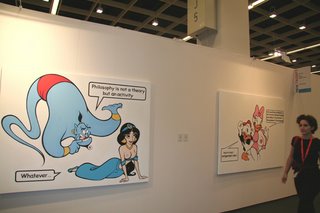Most artists strive for commercial acceptance and success. There are several paths to achieving those (often elusive) goals, commercial galleries being one of them. But if you’re having difficulty breaking into a commercial gallery or if you feel you might not be ready for one yet, there are many alternative spaces that you may want to consider.
I have to admit that I live in a town with two universities and a thriving art scene, so you can hardly go anywhere around here without seeing artwork from local artists and art students. But I’m sure you can find similar venues in your town.
I'm not going to cover
rental galleries, vanity galleries, and
community art centers. I'm going to focus on free spaces that might not currently exhibit art.
Some of these alternative spaces include:Libraries
Cafes/restaurants
Coffee shops
Wine shops
Hair salons/spas
Fitness clubs/dojos
Dance studios
Record stores
Bank lobbies
Churches
Basically, any wall is a potential exhibition space.Do some research. Visit different businesses in your town and notice if they have artwork hanging in their space. If they have changing exhibits, ask to speak to the person in charge of the artwork. Ask him or her about submission guidelines – would they like to see slides or a CD, view your website, or see actual work?
Carry a packet of information (or brochure or business card or CD) around with you to leave behind if the opportunity arises.
Approach businesses or spaces that relate to your work.If you paint floral still lifes, you might approach a flower shop, garden shop, or a botanical garden. Figurative work might lend itself to a day spa. Landscapes from your trip to Italy would look great in that little Italian restaurant. Asian-inspired work might appeal to the owners of a dojo or karate school. Photographs of dancers in a dance studio. Watercolors of historic missions in your local Catholic church. You get the idea…
Some businesses that currently exhibit artwork from local artists might also already do receptions. If they don’t, you might brainstorm about how to do your own reception. They might be open to live music, jugglers, dancers, etc. Try to find something that would be mutually beneficial to both of you – getting your work seen and bringing in customers to the restaurant or shop.
Unused and empty retail spacesConsider approaching the owner of a vacant space that would lend itself to your work. Maybe there’s an empty store on your town square that you could borrow or rent fairly cheaply for a couple of weeks. You would need to consider how to staff the space – posting specific gallery hours and having someone work as a gallery sitter.
HousesA couple of years ago I went to a show at a gallery space that was actually a house. A couple of art students were renting a house and realized that they had a room that they weren’t using. They emptied out that room as well as their living room. Then they invited artists to have short (usually one or two-day) shows. They also knew music students and invited them to provide music for the reception/parties.
Things to considerTrust your instincts.If a restaurant owner seems shady or untrustworthy, tell them thanks anyway. Work out the details of sales – if they handle sales then usually they will take a commission. If they don’t want to deal with sales, they might have interested patrons contact you directly.
Find out what the venue will provide.Some restaurants or shops might already have receptions and PR in place. You can just hang your show and show up for the reception. But others might leave that all up to you. If so, then you'll need to decide how you want to market the show. Consider
writing a press release and
sending out postcards to promote the show.
Be sure to have contact info available during your show.Frame and hang an artist’s statement. Leave a stack of business cards or brochures.
It may be a great opportunity to show, but not sell.If you look at it as a way to show your work to people who wouldn’t normally see it, then you’ll have a good experience. If you expect to sell every piece, then you might be disappointed.
Strength in numbers.Enlist a group of artists to have a show with you. Find artists who do work in a similar theme, similar format, similar medium, etc. Having a group and assigning tasks helps to alleviate the work load associated with mounting a show.
What are some other alternative spaces that you’ve exhibited in? Were they successful? What did you do to make them successful?






